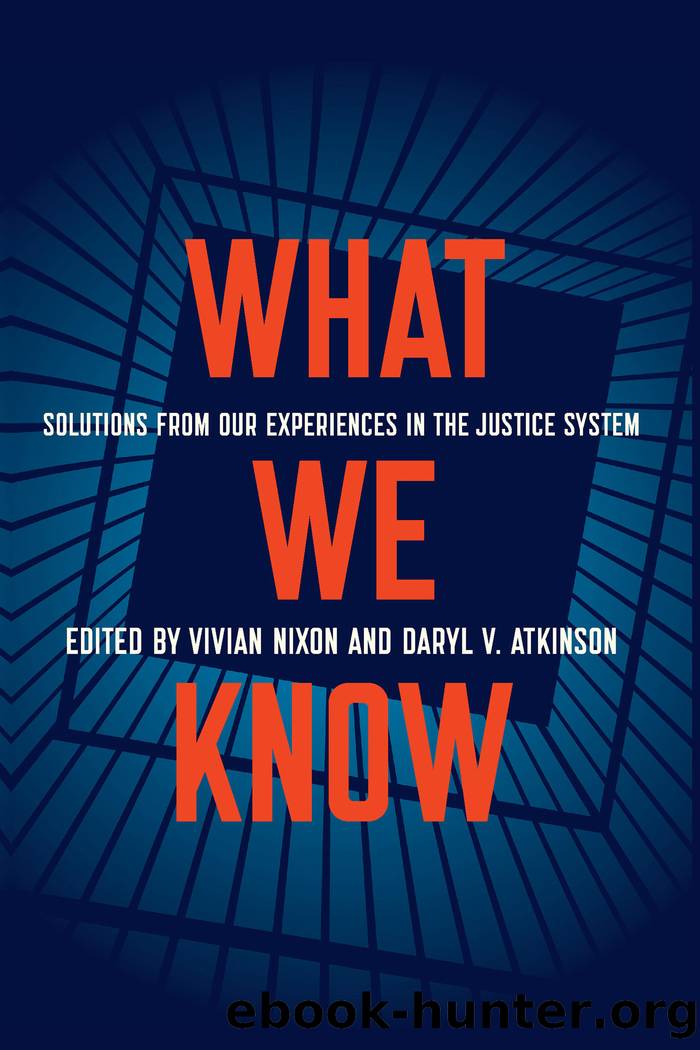What We Know by Unknown

Author:Unknown
Language: eng
Format: epub
Publisher: The New Press
Published: 2020-07-14T16:00:00+00:00
13
The 13th and the Problem of the Color Line
Mika’il DeVeaux, PhD
Professor DeVeaux was formerly incarcerated and is currently a lecturer at Nassau Community College, part of the SUNY system. He is the co-founder and executive director of Citizens Against Recidivism, Inc., directs the Muslim Reentry Initiative, and is a certified anger management facilitator. Dr. DeVeaux is also the founder and principal at DeVeaux Association, a consulting firm that provides evaluation, monitoring, and other services for nonprofits. He discusses the 13th Amendment and its relevance across every aspect of justice reform.
The framers of the U.S. Constitution knew all along that the 13th Amendment was written to address one concern: “the problem of the color line.” That problem, as articulated by W.E.B. DuBois, speaks simultaneously to the historical relationship between people of African descent and the United States, the systematic effort to destroy Afrocentric notions of self, and the construction of a negative black identity.
I learned about my connection to the 13th Amendment during the thirty-two years I spent under correctional supervision, which, according to a literal reading and interpretation of the amendment, made me a slave of the state. In every maximum-security prison where I was confined, I was forced to work mopping floors, mowing grass, or doing some other menial task until I figured out how to do other work that I felt was less demeaning. Even so, those changes were reminiscent of a slight adjustment in status. I had moved from being a slave in the field to one in the big house. Then I took “clerk jobs” that came with a few perks. For example, in some instances I was a chaplain’s clerk and given an “institutional pass” that allowed me to move about the prison unescorted. On another occasion I became a clerk in the mess hall and had access to fresh vegetables, extra food, and regular showers. Rather than become complacent, I knew that I was still a slave and sought a much broader understanding about the context of my situation. I began to examine stories about the past to inform my contemporary analysis, thinking about what could be done to dismantle the foundation of the U.S. system of incarceration.
While in state prison I learned of the raw power of the state and its administrators. I arrived in state prison in 1979. In each prison I was confined—Sing Sing, Comstock, Clinton, Attica, Auburn, and others—I could still smell the smoke from the 1971 Attica riot and the stench of the dead bodies in the air. Day-to-day prison life experience was pathological. The conditions of confinement were emasculating, humiliating, and dehumanizing. I never envisioned the kind of suffering I would experience as a consequence of violating the law, nor did I think the treatment I received was compatible with the stated function of incarceration, the aims of rehabilitation, or the goal of positive social adjustment and service upon my expected return. I still cannot remember why I was surprised when they said, “Get in that cell, nigga.”
Download
This site does not store any files on its server. We only index and link to content provided by other sites. Please contact the content providers to delete copyright contents if any and email us, we'll remove relevant links or contents immediately.
| Aeronautics & Astronautics | Astronomy |
| Astrophysics & Space Science | Comets, Meteors & Asteroids |
| Cosmology | Mars |
| Solar System | Star-Gazing |
| Telescopes | UFOs |
Turbulence by E. J. Noyes(7031)
Tools of Titans by Timothy Ferriss(6934)
Astrophysics for People in a Hurry by Neil DeGrasse Tyson(4613)
Room 212 by Kate Stewart(4099)
Pale Blue Dot by Carl Sagan(3995)
The David Icke Guide to the Global Conspiracy (and how to end it) by David Icke(3875)
Secrets of Antigravity Propulsion: Tesla, UFOs, and Classified Aerospace Technology by Ph.D. Paul A. Laviolette(3430)
Apollo 8 by Jeffrey Kluger(3196)
Losing the Nobel Prize by Brian Keating(3183)
A Journey Through Divination and Astronomy by Publishing Pottermore(3023)
Goodbye Paradise(2948)
COSMOS by Carl Sagan(2944)
Brief Answers to the Big Questions by Stephen Hawking(2872)
How to Read Water: Clues and Patterns from Puddles to the Sea (Natural Navigation) by Tristan Gooley(2849)
The Five People You Meet in Heaven by Mitch Albom(2833)
The Order of Time by Carlo Rovelli(2708)
How to Read Nature by Tristan Gooley(2657)
A Brief History of Time by Stephen Hawking(2470)
Aliens by Jim Al-Khalili(2376)
